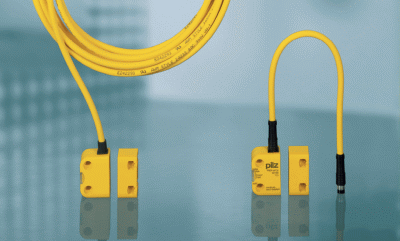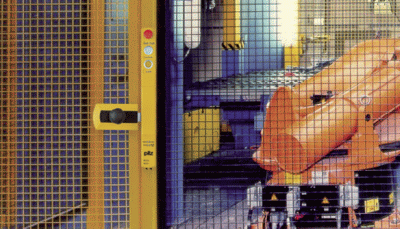 Safety gates, protective covers and machine guards prevent hazards associated with moving parts. However, the correct functioning of a safeguard can only be guaranteed by using the appropriate sensor technology. Alex Bryce, Pilz Automation Technology sales manager considers the sensor systems available how to choose the right one
Safety gates, protective covers and machine guards prevent hazards associated with moving parts. However, the correct functioning of a safeguard can only be guaranteed by using the appropriate sensor technology. Alex Bryce, Pilz Automation Technology sales manager considers the sensor systems available how to choose the right one
Sensor systems operate using different principles and so designers need to fully understand the implications of using each type. The challenge is to try to harmonise productivity with machine safety and user-friendliness. If a safeguard is not user-friendly, there may be a temptation to manipulate a safety guard, putting the machine operator at risk. Designers need to identify potential cases in which safety devices might be manipulated and eliminate these at the machine development stage.
Certain considerations will help the designer to decide which components to use for safely monitoring movable guards in accordance with EN 60947-5-3. Typical questions to ask include: Is the cover frequently opened and closed? Does the process need protecting as well as the operator? Are components exposed to high vibration or extreme temperature, or are they used in potentially explosive areas?
Mechanical safety switches
For simple safety gate applications where there is no increased risk of manipulation, mechanical safety gate switches are widely used. These are used for simple safety gate monitoring or with a mechanical guard locking device, which uses increased extraction force on the actuator to prevent the gate or cover from being opened unintentionally. Many applications require two mechanical switches to guarantee the required level of safety, which increases engineering costs.
Another consideration is that swarf can be deposited on the sensor, restricting its function. Also, safety gates drop over the course of time reducing the lifetime of a mechanical switch considerably.
Mechanical safety bolts are complete solutions comprising a safety switch, handle and bolt. These provide protection where safety gates are difficult to adjust, as well as on safety gates that are frequently opened and closed. A mechanical guide on the actuator ensures the actuator engages with the safety switch correctly when the safeguard is closed. Mechanical hinge switches provide an elegant solution for rotating or hinged gates and flaps. These provide better protection against manipulation compared with other mechanical solutions because they are concealed within the hinge, which saves on installation space.
Non-contact safety switches
Gates, covers and flaps often need to be opened repeatedly for operational or assembly purposes, to enable operators to access or reach the protected area. Here, the risk of a gate being mechanically misaligned is high.
The disadvantage of mechanical guard locking devices is they only have limited tolerance for misaligned gates. For this reason, non-contact safety switches provide an attractive alternative, particularly if there are high vibrations. These switches have a higher response tolerance.
Rugged non-contact switches are also suitable for applications that require protection types higher than IP67. These switches are able to meet safety requirements up to PLe of EN ISO 13849-1, and SIL 3 of EN/IEC 62061, or Category 4 of EN 954-1.
 When it comes to deciding on the acting principle of the sensor, important distinctions need to be made. While magnetic safety switches provide only limited protection against manipulation due to the technology used, coded safety switches achieve up to 100 per cent protection against manipulation. As a result, magnetic safety switches should be concealed or installed in such a way that they are invisible to operators.
When it comes to deciding on the acting principle of the sensor, important distinctions need to be made. While magnetic safety switches provide only limited protection against manipulation due to the technology used, coded safety switches achieve up to 100 per cent protection against manipulation. As a result, magnetic safety switches should be concealed or installed in such a way that they are invisible to operators.
If a safety switch cannot be concealed or if 100 per cent protection is required, RFID coded safety switches are ideal. RFID technology enables a clear assignment between sensor and actuator. RFID coded safety switches operate in accordance with the ‘key lock principle’ whereby only one key – a unique version – fits a lock. Given that the actuator is installed using one-way screws – which can only be loosened via a special tool – a very high level of protection against manipulation is achieved.
Magnetic safety switches have limited suitability if metal swarf is present, which could lead to operational problems or failures. Plant availability and productivity will suffer. Here, coded switches are ideal, as RFID is unaffected by metal swarf.
Various coding types mean different levels can be achieved in terms of security against manipulation. The greatest protection is provided by systems in which an actuator is uniquely assigned to a switch. Sensors with ‘normal’ coding are also available if the demands on manipulation protection are less stringent.
Gate closed in case of danger
Risks can remain even after a machine has been shut down, due to moving parts. In ‘hazardous overrun’ cases such as these, the use of a safeguard locking device is mandatory meaning the gate cannot be re-opened until standstill has been safely detected or a time delay has elapsed. Here, mechanical guard locking devices with spring interlocks guarantees the gate can only be opened when it is safe to do so.
Integrated systems
More can be achieved by using integrated safety gate systems that combine safe monitoring, safe guard locking and control elements, including functions such as E-stop and escape release. All components are integrated. Complete systems such as these help reduce the time and costs associated with project configuration, design, documentation, purchasing and installation. Furthermore, if sensors and evaluation devices are sourced from a single supplier the interfaces between the various components are already compatible.

